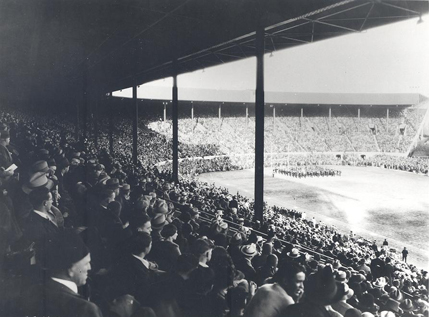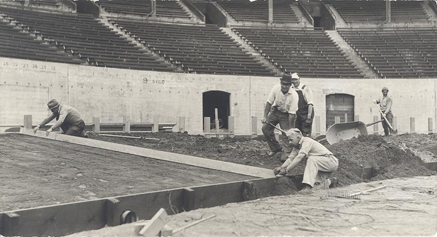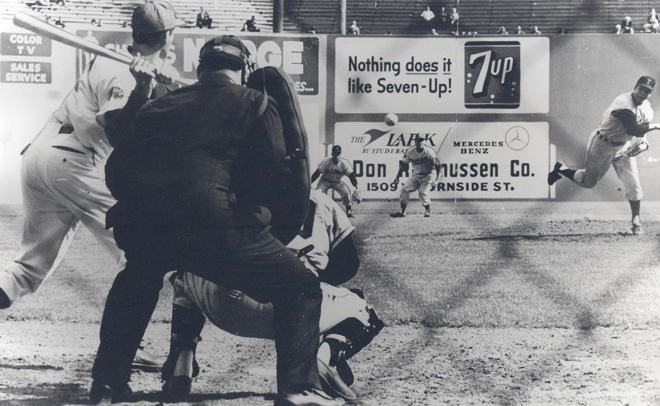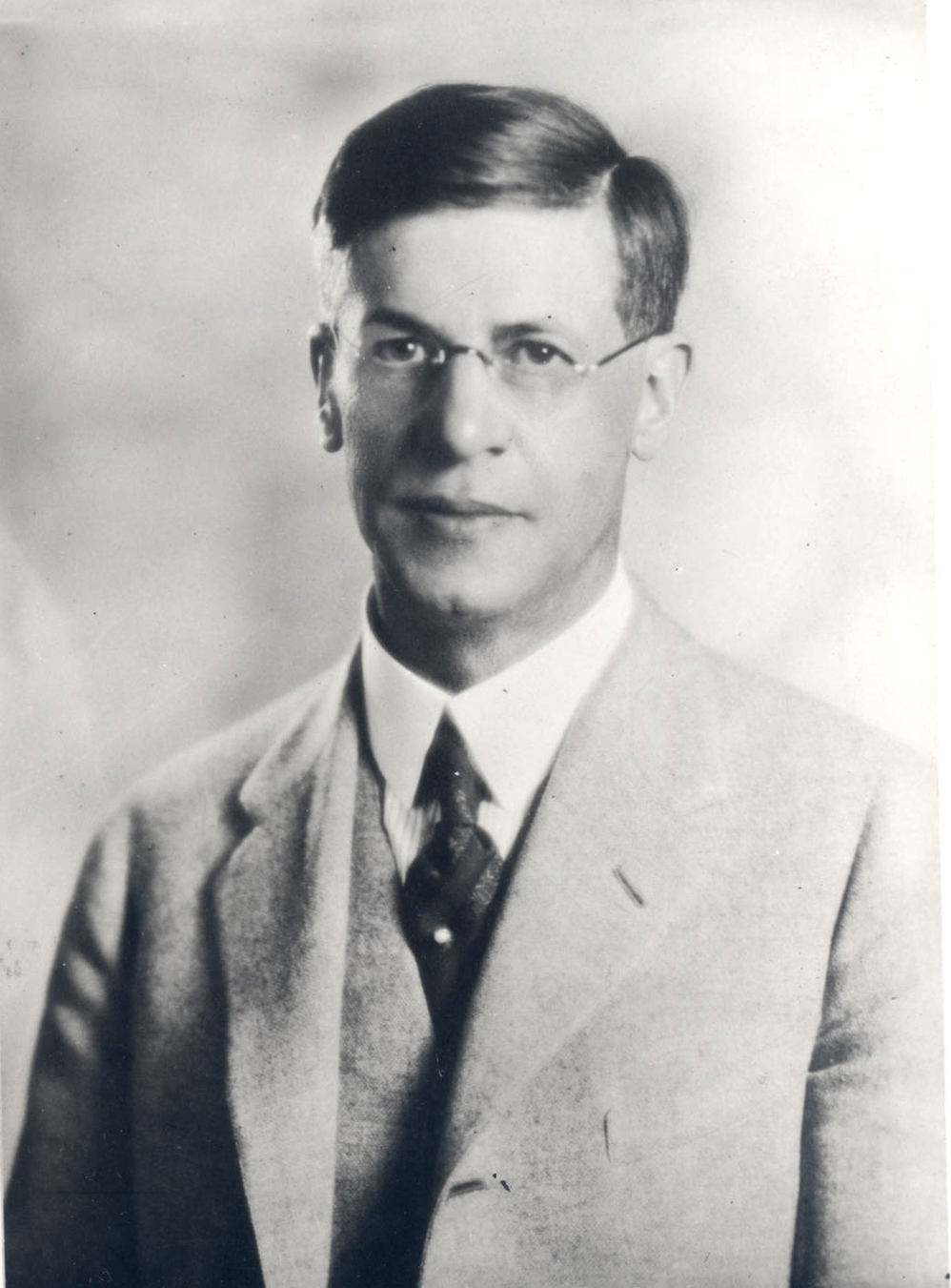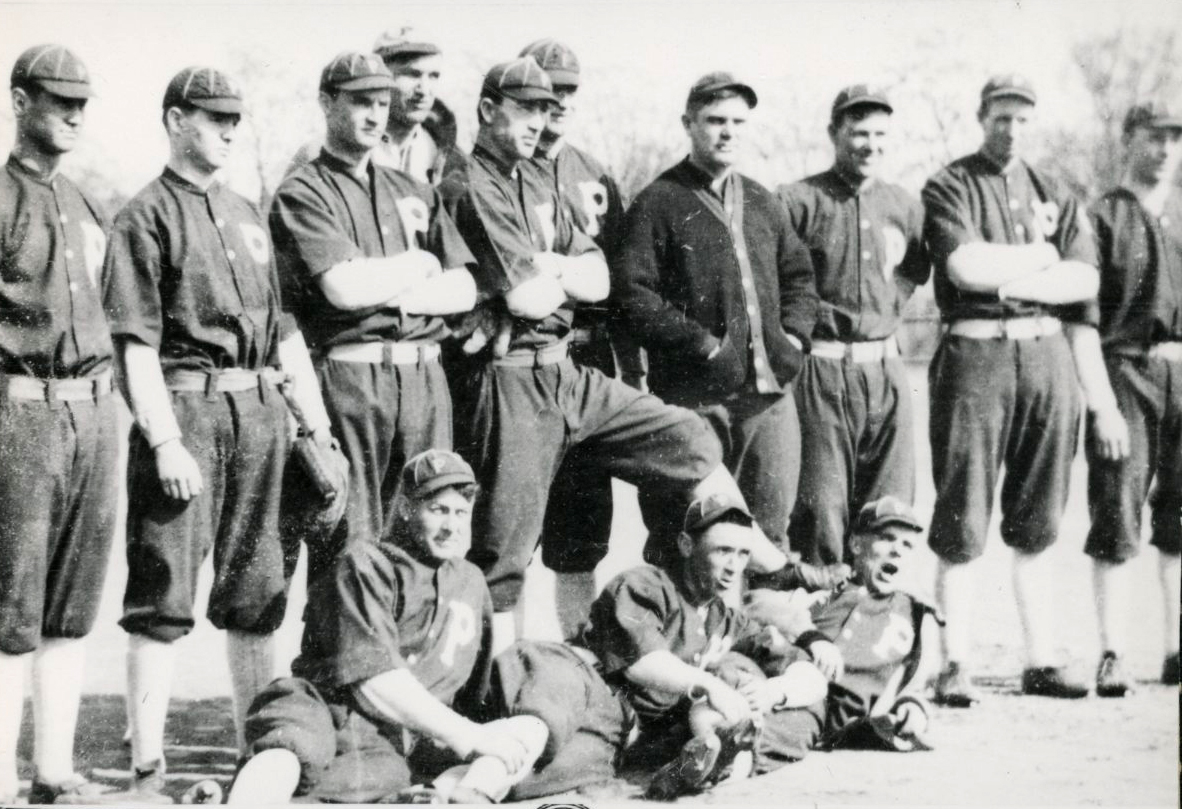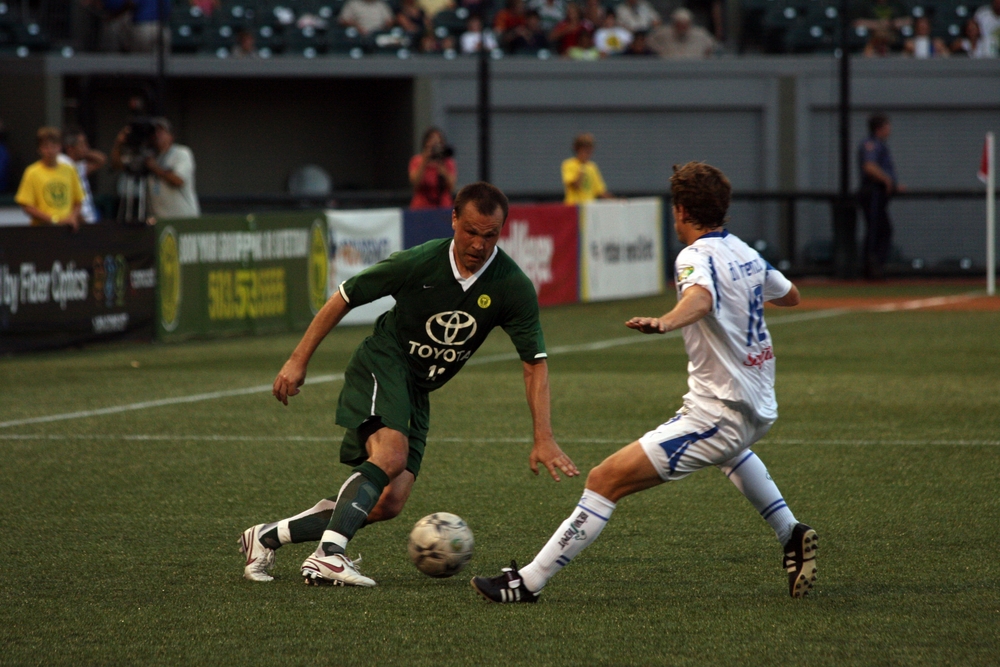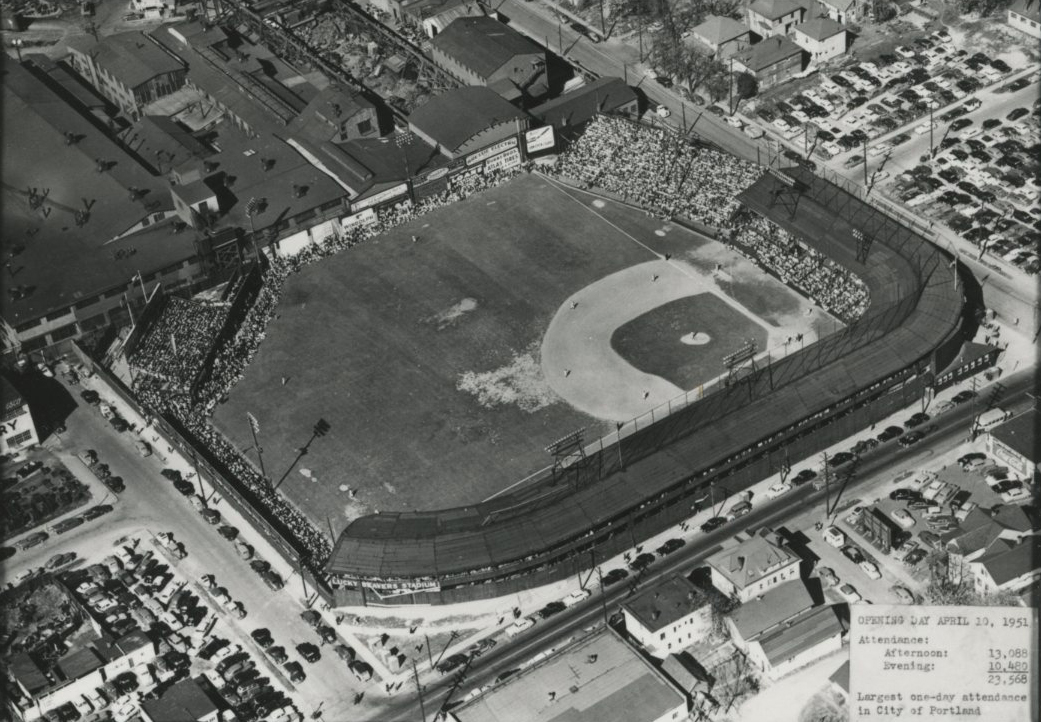Multnomah Stadium—also known as Civic Stadium, Portland General Electric (PGE) Park, Jeld-Wen Field, and Providence Park—was built in 1926 between Southwest 18th and 20th Avenues on Southwest Morrison Street. It was constructed at the expense of the Multnomah Amateur Athletic Club (MAAC) on a site leased or owned by the club since 1893. A grandstand was erected in the spring of 1893, and the MAAC built its first clubhouse across the field from it in 1900.
President William Howard Taft spoke in Portland at the athletic field in 1909, not long before a fire destroyed the MAAC clubhouse, grandstand, and the adjacent Exposition Building in the summer of 1910. In 1911, Theodore Roosevelt set the cornerstone for the MAAC’s new clubhouse on the south side of the athletic field, and the club replaced the grandstand.
The MAAC had been using the field for its athletic program, as well as leasing it out for various sporting and civic events such as college football games and public meetings. The events attracted large crowds, which overwhelmed the limited and weather-damaged bleachers, prompting the club to expand the grandstand and build covered seating. By 1923, Multnomah Field had become such an important venue for the city (it hosted a huge crowd during a visit from President Warren G. Harding that summer) that the MAAC decided to erect a north grandstand to replace rotting wooden bleachers, giving the field permanent stands on two sides.
The growth of the club and a booming economy allowed the MAAC to plan a stadium to replace the small grandstands at Multnomah Field. Plans initially called for a horseshoe-shaped, two-tiered concrete stadium with a capacity of 100,000. By the time construction began in 1926, the MAAC had enough money to build two-thirds of a horseshoe with one level of seats, with seating capacity for 35,000 people at a cost of $500,000.
Designed by club member Morris Whitehouse, in association with architect A.E. Doyle, Multnomah Stadium was completed in time for the annual University of Oregon–University of Washington football game on October 9, 1926. A crowd of 27,300 fans turned out to see the Huskies defeat the Ducks, 23-9. In 1930, the UO-UW game drew a record 35,266, an attendance number that stood until 1975.
In 1933, pari-mutuel betting was legalized in Oregon, and by May 23 of that year the Multnomah Kennel Club hosted its first race on the stadium’s new track. The Kennel Club maintained its headquarters at the stadium until 1956, when the track was removed.
The dog-racing track was demolished, and an outfield wall was constructed in its place on the east side of the stadium, providing the first proper baseball dimensions since the site was first used for sport. The Beavers, Portland’s minor league baseball team, moved into Multnomah Stadium in the spring of 1956. Infield sod came from Vaughn Street Park, where the team had been playing. Minor league baseball would be a fixture at the stadium through 2010.
The MAAC, in an effort to increase its clout among West Coast sports clubs and attract large-scale events, had transformed Multnomah Stadium into a major athletic venue in the forty years it owned and operated the arena. In 1966, the club, now called the Multnomah Athletic Club (MAC), needed capital and sold the stadium to the City of Portland for $2.1 million shortly after voters had rejected two proposals for a new stadium at Delta Park. Just three years later, the city installed Tartan Turf at a cost of $343,000, giving Civic Stadium the nation’s first outdoor multi-purpose artificial turf.
In 1975, the Portland Timbers soccer team drew 35,503 for their North American Soccer League semifinal against the St. Louis Stars, breaking the forty-five-year-old stadium record. Two years later, the stadium hosted Soccer Bowl ’77, where Brazilian soccer player Edson Arantes do Nascimento, known as Pelé, played his final professional match in front of 35,548.
During the winter of 1981-1982, Civic Stadium’s original roof was replaced at a cost of $9.5 million. The new roof covered a much higher percentage of seats and required the construction of a new press box but otherwise left the stadium unchanged.
In 2001, with the return of the Portland Beavers baseball team and the Portland Timbers soccer team, Civic Stadium was significantly upgraded and named after a sponsor for the first time. The $38.5 million renovation of PGE Park removed outfield seats, constructed luxury boxes and office space, and installed NeXturf, the latest in artificial turf technology. The stadium accommodated 19,566 people.
As the Timbers soccer team grew in stature over the early twenty-first century, altering the stadium again to reflect the shift from baseball to soccer became a priority. In July 2009, the Portland City Council approved a $31 million soccer-specific upgrade, permanently removing the capacity to play baseball in the stadium and constructing an independent east-side stand. Reopened in April 2011, under the name Jeld-Wen Field, the stadium accommodated 18,627 for the home debut of the Timbers in Major League Soccer. The stadium capacity was increased to 20,323 for the 2012 season. In January 2014, the stadium was rebranded as Providence Park as part of an agreement with Providence Health & Services.
-
![Multnomah Stadium]()
Multnomah Stadium (Civic Stadium, PGE Park, JELD-WEN Field).
Multnomah Stadium Courtesy Oreg. Hist. Soc. Research Lib., Orhi75327
-
![Civic Stadium, 1959]()
Civic Stadium, 1959.
Civic Stadium, 1959 Courtesy Oreg. Hist. Soc. Research Lib., orhi91929
-
![Shriners, Grand Review]()
Shriners, Grand Review.
Shriners, Grand Review Courtesy Oreg. Hist. Soc. Research Lib., 282-B
-
![Greyhound racing track, 1933]()
Greyhound racing track, 1933.
Greyhound racing track, 1933 Courtesy Oreg. Hist. Soc. Research Lib., 85242
-
![High school football game, 1938]()
High school football game, 1938.
High school football game, 1938 Courtesy Oreg. Hist. Soc. Research Lib., 81082
-
![Construction, 1926]()
Construction, 1926.
Construction, 1926 Courtesy Oreg. Hist. Soc. Research Lib., 66390
-
![Portland School children, photo by Fred Kiser]()
Portland School children.
Portland School children, photo by Fred Kiser Courtesy Oreg. Hist. Soc. Research Lib., cn024639
-
![Multnomah Stadium, 1915]()
Multnomah Stadium, 1915.
Multnomah Stadium, 1915 Courtesy Oreg. Hist. Soc. Research Lib., orhi91267
-
![May Fest at Multnomah Field, photo by B. Gifford]()
May Fest at Multnomah Field.
May Fest at Multnomah Field, photo by B. Gifford Courtesy Oreg. Hist. Soc. Research Lib., GI487
-
![Tanner Creek floods stadium, 1904]()
Tanner Creek floods stadium, 1904.
Tanner Creek floods stadium, 1904 Courtesy Oreg. Hist. Soc. Research Lib.
-
![Portland Beavers opening day, April 1960]()
Portland Beavers opening day, April 1960.
Portland Beavers opening day, April 1960 Courtesy Oreg. Hist. Soc. Research Lib.,OrHi934
Related Entries
-
![Albert E. Doyle (1877-1928)]()
Albert E. Doyle (1877-1928)
Albert Ernest Doyle was one of Portland’s most successful early twentie…
-
![Morris Whitehouse (1878-1944)]()
Morris Whitehouse (1878-1944)
Over the course of his career, Morris Whitehouse designed many importan…
-
![Multnomah Athletic Club]()
Multnomah Athletic Club
Founded in 1891, the Multnomah Athletic Club (MAC) is considered Oregon…
-
![Portland Beavers (baseball team)]()
Portland Beavers (baseball team)
The Portland Beavers represented Portland in minor league baseball for …
-
Portland Timbers
Local soccer aficionados may remember the glory days of the Timbers—the…
-
Portland Timbers, 1975 season
The Portland Timbers soccer club came into existence in January 1975. B…
-
![Vaughn Street Park]()
Vaughn Street Park
Vaughn Street Park, as most Portlanders called it, was built in 1901 by…
Related Historical Records
Map This on the Oregon History WayFinder
The Oregon History Wayfinder is an interactive map that identifies significant places, people, and events in Oregon history.
Further Reading
Godfrey, Louise R. A History of the Multnomah Amateur Athletic Club. Portland: The Club, 1967.
McIvor, Kristyn, Joel A. Freeman, and Luana Hellmann Hill. Legacy of the Twenty-six: a Celebration of the First 100 Years of the Multnomah Athletic Club. Portland: Multnomah Athletic Club, 1991.
Wong, Marie Rose. Sweet Cakes, Long Journey: the Chinatowns of Portland, Oregon. Seattle: University of Washington, 2003.



